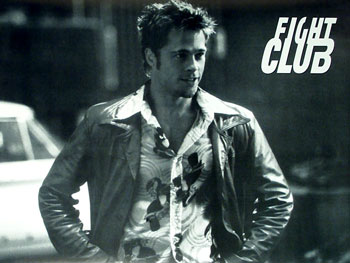
Fight
Club
by Ben Schingel
![]()
_____________________________________________
In 1996, author Chuck Palahniuk made his publishing debut. His first novel
was the darkly clever Fight Club. Quickly becoming an underground
classic, Palahniuk's book offered a tale of a man whose lack of fulfillment
with society led to relief through secret, underground fighting matches
hosted in the basements of local bars. This Fight Club, founded
with the man's friend, Tyler Durden, is a way for him and his friends
to cope with their mundane lives. The psychological adventure which follows
offers amazing suspense and biting commentary on life in a consumerist
society.
It wasn't long before the novel found its way into the hands of a young film director by the name of David Fincher. Fincher, riding on the successes of films such as Seven and Alien3, sought to make Fight Club into a motion picture. The black humor and grim reality found on the pages of Palahniuk's novel lent themselves perfectly to Fincher's dark, gritty directorial style. Fincher sought the casting of Seven star Brad Pitt and Academy Award winner Edward Norton. Although their brilliant performances were an important element of Fight Club, the dark cerebral underworld of Palahniuk's novel is realized to its fullest through Fincher's use of color, editing, and score.
The colors in Fight Club come in two separate packages, the world of "Jack" and the world of "Tyler". In Jack's world, everything is overexposed, bright and luminescent. These artificial colors of Jack's home and professional life are the reflection of his consumerism. The greenish, halogen glow of his surroundings suggest the discomfort of his chronic insomnia and the burning dissatisfaction he feels for his everyday, young professional lifestyle. Tyler's world is the perfect contrast to Jack's. His surroundings are poorly lit, cluttered, yellowed and decaying. This contrast portrays Jack's need to escape in living vicariously through Tyler. By the time of the shocking realization that Jack and Tyler are in fact the same person, the separate palettes of their world have slowly blurred as the characters of the Jack and Tyler blur into a single personality. This grainy darkness, coupled with overexposed and oversaturated use of light and color, helps to signify the chaos in Jack's mind as he becomes more aware of the reality surrounding Tyler Durden.
This internal chaos is further enhanced by the use of editing in the film. Quick, jerky camera movments and jump cuts are used to explain the non-linear thought processes of Jack's mind. The film, like the novel, begins just momenta before the story's conclusion. From that moment we are led through a series of out-of-order flashbacks and narrations. This disorienting chain of events portrays perfectly the lack of order in Jack's mind. This confusing use of editing also helps to keep the viewer in suspense until the moment of the film's surprise twist. The sharp cuts between Tyler's dark world and Jack's overexposed reality help to effectively contrast the characters. This perfect blend of editing and color contrast help to further realize the world of Palahniuk's novel.
However, color and editing alone do not complete the film's portrayal of Fight Club. The score, which consists of original compositions by U.K. electronic outfit, The Chemical Bothers, furthers enhances the emotional aspect of the story. The score is a hodgepodge of contemporary styles ranging from drum-and-bass to avant garde electronics. This contemporary approach to the score helps bring to life the film's postmodern social commentary. The heavy percussion echoes the pounding fists of the fighting while the frenzied, rhythmic compositions push the viewer headlong into Jack's escapism and self-destruction.
This self-destruction
is the ultimate theme behind Fight Club and can be summed up by
Jack's narration, "I felt like putting a bullet between the eyes
of every panda that wouldn't screw to save its species. I wanted to open
the dump valves on oil tankers and smother all those French Beaches I'd
never see. I wanted to breathe smoke . . . I felt like destroying something
beautiful." David Fincher's directing brings Jack's violent world
of escape and unreality to the theatre in the best way imaginable. The
film stays true to the book in nearly every possible aspect. Fincher's
directorial techniques are well-suited to bring about the brilliant realization
of Chuck Palahniuk's amazing novel.
Works Cited
Fight Club. Dir. David Fincher. Perf. Edward Norton
and Bradd Pitt. 20th Century Fox, 1999.